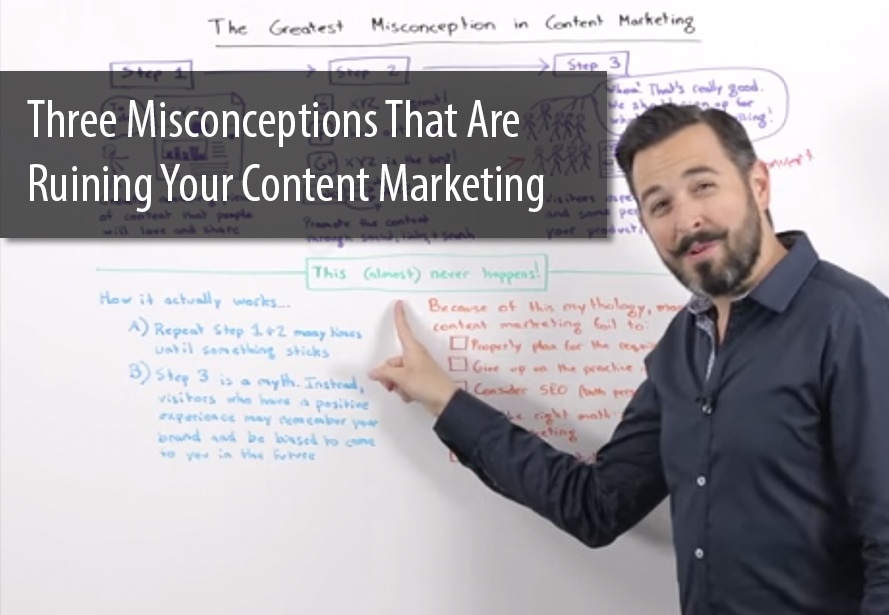Editor's Note: This post was originally published in January 2015 and has been updated for accuracy and comprehensiveness.
6 Reasons Why Your Content Isn't Generating Leads
So, you have a content marketing strategy in place, and you're delivering content via your website on a consistent basis, but you're just not generating leads. What's up?
Well, there may be several factors at play. Let's take a look at a few of them:

1. Your website design needs improvement.
Clean, simple design should not be underestimated. Your site's usability, navigation and user experience (UX) are paramount to your content's ability to attract visitors. It's the presentation "package" your content is "wrapped" in. It should be as attractive as possible (design), as easy-to-open as possible (accessibility via navigation), and easy-to-read, meaning the font is legible and the layout incorporates adequate white space with headings and images.
The overall user experience with your website starts with design. If it doesn't capture their attention with your key offerings, or appeal to them in its design, they may go elsewhere to find the information they're looking for.
Key Messages
Your home page should deliver brand positioning, value proposition and what problems your company solves/what you do in 15 seconds or less. It's your online elevator pitch. If it isn't successful, visitors have no incentive to go any deeper into your site. That being said, the 15-sec. pitch should be above the fold - requiring no scrolling to obtain that information.
Responsive Design
Your website and its content should be designed and optimized for cross-platform accessibility. With a responsive design approach to your website, you address both desktop and mobile users with one strategy.
These days, having a mobile optimized website is critical. After all, 37% of consumers are more likely to purchase on a mobile-optimized site. Also, B2B executives lead the way in mobile adoption, preferring mobile platforms to conduct research for products and services for their business.
Translated? Your website's mobile compatibility shouldn't be an afterthought – it should be at the forefront of your digital marketing strategy in order for your business to deliver the same content to whichever device your visitors choose to obtain it.
Regular Updates
Your website shouldn't be static. It's not a piece of collateral you update and publish once a year. Make tweaks regularly to demonstrate your interest in those visiting it. It's sort of like dating: you wouldn't wear the same outfit over and over at the beginning of a relationship, would you? (Full disclosure here - I have.)
Your website is like a living organism that needs regular attention. Give your visitors one more reason to keep coming back to your site. Keep it alive and fresh. And don't overlook business blogging – it's a great way to add fresh, dynamic content to your site.
2. Your buyer personas and buyer journeys are amiss.
If content isn't generating leads, then perhaps you are beginning to lose site of your buyers, or the deep knowledge you had on your buyers is no longer accurate. An obvious starting point to fix this situation is to re-examine your buyer personas.
Just as websites aren't static, neither are buyers. Their wants and needs change, as do the problems and challenges they face. Maybe it's time to revisit your buyer personas. Start by asking your customers what their pain points are, and adapt your buyer personas and content accordingly.
In conjunction with buyer personas are the buyer's journey – the stage they are in on the path-to-purchase. While your buyer personas may be dead on, you simply may have missed opportunities to convert visitors to leads because the right content was delivered at the wrong time. Timing is everything. If content doesn't map to your prospect's current stage of the buyer's journey, they don't have a reason to act on it.
3. Your CTAs aren't compelling.
This one is key. As content producers, we're covering a broad range of topics to attract prospective buyers and engage existing customers. But are you limited by the Calls-To-Action in your arsenal? While focusing on new content and frequency are important, if you don't have contextual and relevant CTAs to prompt that visitor to take the next step, your attempts won't yield returns. You may have produced targeted content and reached your buyer persona at the right time on the buyer's journey, but if the CTA doesn't map to the content delivered, there is no incentive for that visitor to go further – and you've lost a lead.
Take a look at your content editorial calendar and current inventory of CTAs. Do they sync with the topics? Consider creating new CTAs to add to your inventory such as e-books, infographics, white papers, industry reports, templates, best practices, how-to guides, videos, webinars, presentations, etc. The more you have available to you, the greater the chances for their relevancy and success in converting visitors to leads.
4. Not enough visual content.
Visual content such as images, videos, pictures and infographics are easier to consume. Investing in content that's visual, or that contains a visual component, may be money and time well spent.
Visual content designed well is informative, useful, and requires less commitment from your reader in terms of time and effort to consume it (as opposed to say, reading a several hundred word blog). Make it easy for visitors to consume your educational, actionable content through the use of more visual assets.
5. Lack of credible content.
Content that's credible has the greatest leverage with prospects. Customer testimonials, case studies, success stories and video testimonials are great examples. And when it comes to middle-of-funnel conversions, this type of content is not only engaging, but it also offers a strong ROI. People would rather listen to validation of your products and services directly from those using them.
In many A/B Split Tests, testimonials can increase conversion as much as 50%. Why? They promote confidence and trust in your company. These types of content lead the way in building customer relationships.
6. Your content doesn't solve problems.
Did you know that 94% of B2B buyers conduct online research before making a purchase decision? These buyers are using content to get the answers they need before making a purchase. So keep in mind that your content needs to be more than just engaging – it needs to be educational and it needs to help solve a specific problem.
As mentioned earlier, the challenges your customers face may change. Consider asking them on a regular basis what those challenges are and address them with your content strategy. Identify hot topics and industry trends, and conduct a survey asking them to choose topics based on need or interest. Give them the information they seek in order to help solve their business problems.
Conclusion
Sometimes our efforts don't yield our intended results. The important thing is the ability to recognize a need for improvement. Through performance measurement and analytics, you can identify when your website/content isn't generating leads, so you can focus on why.
Share this
You May Also Like
These Related Stories

How to Perform a Content Audit

Your Content Isn't Working - These 3 Videos Explain Why


/Accreditations/CRM-Implementation-Accredited-Badges.png?width=170&height=138&name=CRM-Implementation-Accredited-Badges.png)
/Accreditations/Onboarding-Accredited-Badges.png?width=170&height=137&name=Onboarding-Accredited-Badges.png)
/Accreditations/Custom-Integration-Accredited-Badges.png?width=170&height=137&name=Custom-Integration-Accredited-Badges.png)

